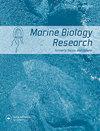本地乳酸菌对副溶血性弧菌攻击卤虫的保护作用:体外和计算机研究
IF 1.2
4区 生物学
Q4 ECOLOGY
引用次数: 0
摘要
本文章由计算机程序翻译,如有差异,请以英文原文为准。
Protective effects of indigenous lactic acid bacteria in Artemia salina challenged with Vibrio parahaemolyticus: an in vitro and in silico approach
ABSTRACT Aquaculture is one of the fastest-growing sectors of the food industry and vibriosis is a major disease affecting finfish and shellfish production capabilities. In recent years, probiotics specifically lactic acid bacteria (LAB) have proven to be an environmentally friendly alternative to antibiotics to maintain aquatic animal health. In this study, five strains of indigenous LAB isolated from traditional and non-traditional sources were evaluated for their potency in the prevention of vibriosis in brine shrimp, Artemia salina as a model organism. The LAB were well tolerated at all doses, and no negative effects on the hatching ability of brine shrimps were observed when exposed to Lactiplantibacillus plantarum KCFe63 and Limosilactobacillus fermentum NCCu21. Furthermore, all the tested LAB were able to protect the brine shrimp from the pathogen Vibrio parahaemolyticus under co-exposure and pre-exposure conditions. Molecular docking analysis revealed a high binding affinity of common probiotic metabolites lactic, butyric and propionic acids to the PirAvp and PirBvp proteins of V. parahaemolyticus which can prevent toxin formation and thereby acute hepatopancreatic necrosis disease (AHPND). Overall results suggest that two strains, L. plantarum KCFe63 and L. fermentum NCCu21, are suitable candidates to reduce the incidence of vibriosis and AHPND during brine shrimp cultivation.
求助全文
通过发布文献求助,成功后即可免费获取论文全文。
去求助
来源期刊

Marine Biology Research
生物-海洋与淡水生物学
CiteScore
2.10
自引率
0.00%
发文量
55
审稿时长
6-12 weeks
期刊介绍:
Marine Biology Research (MBRJ) provides a worldwide forum for key information, ideas and discussion on all areas of marine biology and biological oceanography. Founded in 2005 as a merger of two Scandinavian journals, Sarsia and Ophelia, MBRJ is based today at the Institute of Marine Research, Bergen, Norway. The Journal’s scope encompasses basic and applied research from all oceans and marine habitats and on all marine organisms, the main criterium for acceptance being quality.
 求助内容:
求助内容: 应助结果提醒方式:
应助结果提醒方式:


